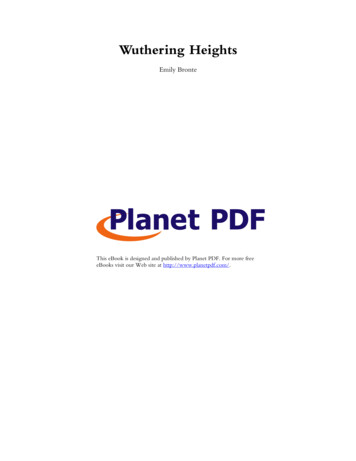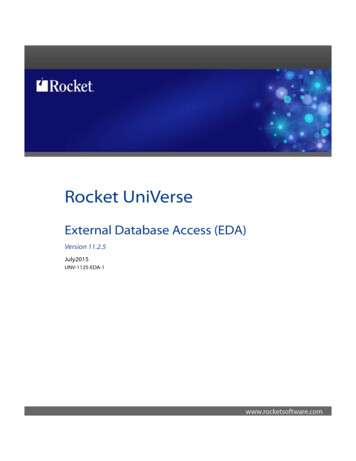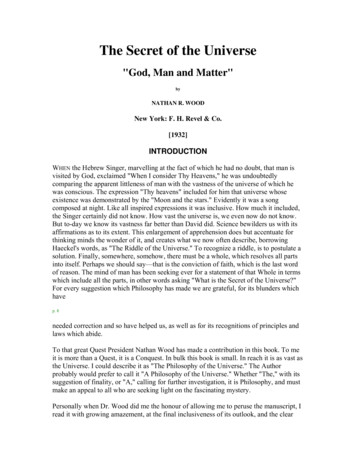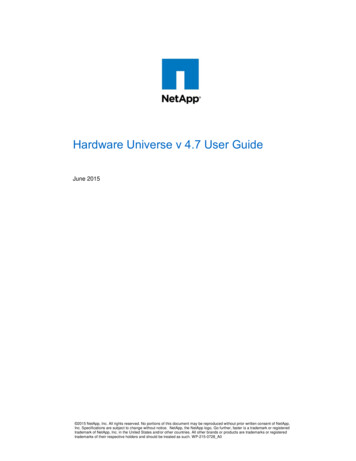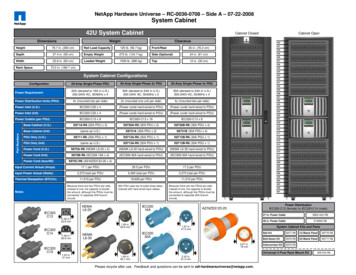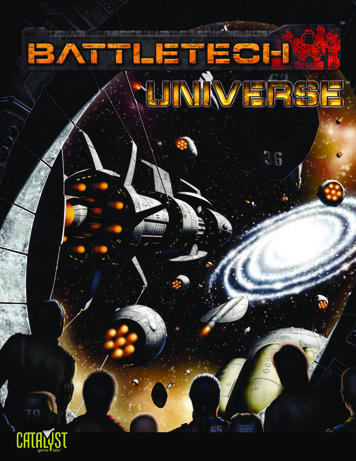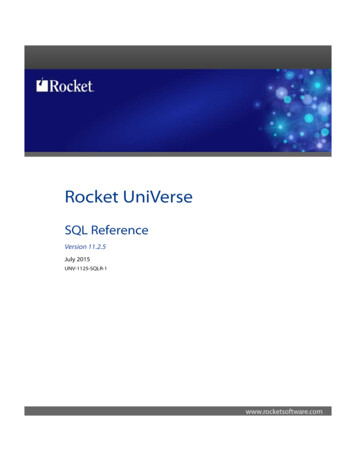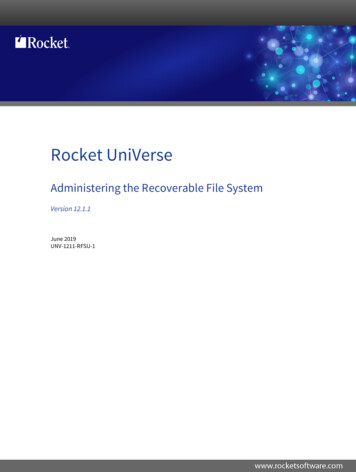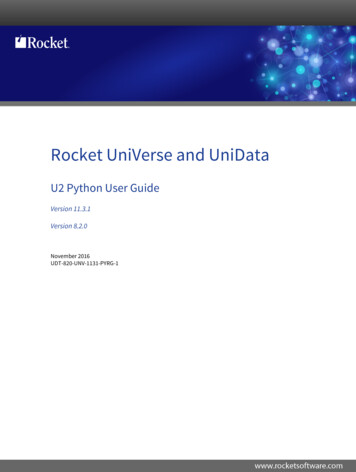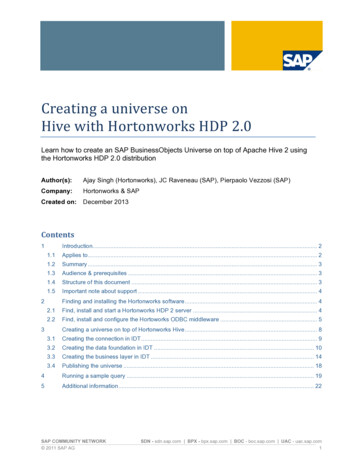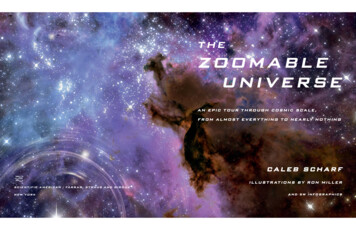
Transcription
T HEZ OOM A BL EUNI V ERSEA N E P IC T OUR T HR OUGH C O SMIC SC A L E ,F R OM A L MO S T E V E R Y T HING T O NE A R LY NO T HINGC A L E B SCH A R FIL L US T R AT IONS B Y R ON MIL L E RS C I E N T I F I C A M E R I C A N / FA R R A R , S T R A U S A N D G I R O U XNE W Y OR KA ND 5 W INF O GR A P HIC S
CON T E N T SPreface1.2.3.4.5.6.7.8.9.10.ixAlmost Everything 3Darkness and Light 23The Slow, the Fast, and the Fantastic 49Planets, Planets, Planets 69A World We Call Earth 93Being Conscious in the Cosmos 115From Many to One 129The Undergrowth 145The Emptiness of Matter 159It’s Full of . . . Fields 175From Nearly Nothing to Almost Everything 191Notes 195Acknowledgments 205v ii
P R E FA CEDo you want to hear the most epic story ever?A long time ago the atoms in your body were spread across trillions of kilometers of otherwise empty space. Billions of years in the past there was no hint that they would eventually cometo be configured as your eyes, your skin, your hair, your bones, or the eighty-six billion neuronsof your brain.Many of these atoms came from deep inside a star—perhaps several stars, themselves separated by many trillions of kilometers. As these stars exploded, they hurled matter outward in aflood of scorching gas that filled a small part of one galaxy out of hundreds of billions of othergalaxies, arrayed throughout a gaping maw of space and time almost a trillion trillion kilometers across.Despite being scattered in the cosmos, these atoms eventually became part of a world, ourworld, Earth. They cooled and condensed together, drawn by gravity, becoming new stuff, a billion trillion times denser than when they were just floating in space. For four and a half billionmore years they shape-shifted into lots of different guises.Some of these atoms were part of the very first microscopic bubbles of living complexity inotherwise empty oceans and continents. And many of the very same atoms have been discardedand picked up a billion or more times as they’ve traveled through Earth’s environment.ix
They’ve been in the shell of a trilobite, perhaps thousands of trilobites. They’ve been intentacles, roots, feet, wings, blood, and trillions, quadrillions of bacteria in between. Some havefloated in the eyes of creatures that once looked out across the landscapes of a hundred millionyears ago. Yet others have nestled in the yolks of dinosaur eggs, or hung in the exhaled breath ofa panting creature in the depths of an ice age. For other atoms this is their first time settling intoa living organism, having drifted through eons in oceans and clouds, part of a trillion raindropsor a billion snowflakes. Now, at this instant, they are all here, making you.Each atom is itself a composite that’s about a tenth of a billionth of a meter across—sittingon the precipitous edge of a universe between our perceived reality and the quantum world.Electrons hazily occupy much of the atom’s empty space. Protons and neutrons cluster in a nucleus, a hundred thousand times smaller than its atom, and are themselves composed of otherstupendously small things, quarks and gluons. An electron may have no meaningful propertyof size but can be thought of as ten million times smaller than the nucleus. And, at some point,13.8 billion years ago, all these components of all the atoms in the universe were squeezed intoa far smaller, hugely energetic origin of space and time. Although that origin is now vastly expanded, we’re still inside its envelope, along with any being that may exist a billion light-yearsfrom here. We’re not truly disconnected, even now.It’s quite a tall tale. Except this is not fiction. It’s our current best shot at recounting whathas really happened in the past 13.8 billion years.The purpose of The Zoomable Universe is to try to capture more of this story, to lead youthrough what we know (and what we don’t) about the entirety of nature. To do that we’ve turnedto a tried-and-true approach: the simple premise of a tenfold zooming view to tour the universe,from the edge of the observable cosmos to the innermost knots of reality.The conceit of a journey through the scales of nature is not new, and doing it scientificallygoes back at least as far as Micrographia, published by Robert Hooke in 1665. Works like theseminal 1957 book Cosmic View: The Universe in 40 Jumps, by Kees Boeke, and the short filmsCosmic Zoom, by the National Film Board of Canada (1968), and Powers of Ten, by Charles andRay Eames (1977), as well as many derivatives in subsequent years, demonstrate our universallove of cosmic journeys.It seemed that the time was ripe to make a contribution that not only brought the corematerial fully up to date but added focus on the intricate connectivity of the universe. Atomsxhere in my hand are related to atoms over there, or on the next planet, or halfway across the cosmos. The physics that operates inside us is the same that operates on other scales, and at othercosmic times. And the patterns and emergent phenomena that infuse our day-to-day experiencesshare rules and properties in countless surprising ways throughout nature.From fingers and toes to modern mathematics and measurements, we can all grasp thenotion of powers of ten, sizes that shift by ten times or by a tenth. Chain these sliding scalestogether and we have a language for expressing the continuities and relationships of nature thatextend far outside our ordinary everyday experience. The powers of ten let us zoom from almosteverything to nearly nothing.This book is a synopsis, a cheat sheet if you will. It can’t recount every exact detail of thecontents and history of the universe. Instead, it treats the reality we know as a zoomable mapwith a preset path to follow. In video-game parlance, it’s a “rail shooter.” That rail follows thephysical scales of the cosmos—starting at the top and zooming on down.As we wrote and illustrated this journey, we agonized over how to build this rail. The cosmos has three dimensions of space, and that tricky thing we call time. There are also trillionsof interesting things to take a look at along the way. We’ve tried to balance the idea of a “grandoverview” with making sure we visited some very, very cool places en route.Some of the waypoints are intellectually challenging—even in Chapter 1 you’ll have to contend with the strange concept of dark matter, an expanding universe, and even stranger thingslike multiple universes and multiple versions of you. In Chapter 3 you’ll have to grapple with themajestic origins of the solar system. By Chapter 6 you’ll be puzzling over the nature of consciousness, and by Chapter 9 you’ll be tackling interpretations of quantum mechanics. Don’t worry—the beautiful illustrations and infographics will help delight and inform you along the way.We hope you enjoy finding your own connections among the gloriously varied pieces of dataand knowledge that bring our vision of reality together. Remember, it’s your universe as muchas anyone else’s.xi
1A L MOS T E V E R Y T HING1027, 1026, 1025, 1024 , 1023 metersFrom about 93 billion light-years to 10 million light-yearsFrom the diameter of the cosmic horizon to the size of the Local Group of galaxiesIt’s a summer morning. You’re sitting in a sunlit room holding this book, reading this page, andabout to start a journey through cosmic scale.Looking up, you notice that tiny specks of glowing dust are caught in the beams of lightstreaming through the windows. These bright pinpoints loft and swirl in the air currents, like aswarm of mysterious creatures.The specks are microscopic, yet if the whole room were to represent the size of the observable universe, each of these dusty motes would be the size of an entire galaxy of stars.Now follow a single sunlit speck. This is our galaxy, the Milky Way. It is home to morethan 200 billion stars, and at least that number of planets. These stars and planets span astructure that is a hundred thousand light-years across—a distance of more than nine hundredthousand trillion kilometers. At a walking pace, it would take you twenty trillion years tocross this object.Packed deep inside, hidden among these billions of other worlds, is one particular planetwe call Earth. This world is a modest rocky orb with a thin coating of crystallized mineral crustatop a hot interior, lightly painted with water and atmosphere. It orbits a lonesome star that wecall the Sun—one star, only 4.5 billion years old in a 10-billion-year-old galaxy.Now think about all the things that you know and experience in your life. Your family,3
friends, dogs, cats, small furry rodents, horses, houses, couches, beds, pizza, apples,oranges, trees, flowers, insects, dirt, clouds, water, snow, rain, mud, sunshine, andstarry nights.Then think about all the people who have ever lived (a total of around 110 billionindividual, biologically modern humans) and all that they knew in their lives. All thesepeople, billions upon billions of them, experiencing their surroundings for centuries,decades, years, months, days, hours, seconds, and the blink of an eye.That’s a lot of special moments for human beings. But for 3.5 billion years beforewe came along, living things swarmed the Earth, from bacteria and archaea to multicellular clumps, from trilobites to insects, dinosaurs to cephalopods. Trillions of livingentities slithered around every conceivable niche, compelled into existence by varyingpotentials of chemical energy and chance. During every passing moment of those manyyears, all these organisms were being sculpted and battered by natural selection, anddriven by the restless engines of molecular mechanics.The sum total of that, every single last bit of it, has existed on this one world—avanishingly small mineral dot among billions of mineral dots, all held within a singledust mote that you watch floating through a sunny room that is the universe as weknow it.This one-mote galaxy that we call the Milky Way is a microscopic part of a wrinkly, web-like ocean of matter. That ocean sustains more than 200 billion other galaxies.These galaxies range from small to enormous, some isolated, some in the midst of messycollisions. And these are merely the galaxies from which light has had time to reach usin about thirteen billion years—they’re within our “horizon,” the horizon of light traveltime, like the walls of your room.This cosmic sprawl is also awash in electromagnetic radiation, energy that exhibits both wave- and particle-like behavior, packaged as massless units called photonsracing to and fro across space. Some of this radiation is the product of the early andhot history of the place that we generally call the universe. Other photons are fromspecific, individual sources: stars, supernovas, warmly glowing young planets, cosmiccrashes and shock waves, possibly even plaintive missives hurled between technologicalcivilizations—or not.4The horizon of the observable universe1027
2D A R K NE SS A ND L IGH T1022, 1021, 1020, 1019, 1018 metersFrom about 1.06 million light-years to 106 light-yearsFrom about 8 to 10 Milky Way diameters to the size of a giant molecular cloudImagine that you are an all-powerful alien being who decides to scrunch up all the stars in theMilky Way so that they are packed next to one another. By getting rid of all the space in between,you can fit these stars into a cube only about 8 billion kilometers (or fifty-four times the radiusof Earth’s orbit) on each side. That cube, containing some 200 billion stars, fits neatly within theorbital diameter of Neptune in our solar system. In other words, the galaxy has plenty of surplusroom between its stars.Of course, physics wouldn’t actually let you do this, at least not without making a lot of mess.The problem with putting this much mass in one place is that you’d wind up making a black hole.Why? Because the gravitational pull of all those stars on one another would be irresistible. Weirdly,though, the size of the black hole containing the mass of the 200 billion or more stars of the MilkyWay would be much bigger than our imaginary cube of stars by a factor of about 146.That’s because very massive black holes are actually rather low density if you treat their outermost extent as the measure of their size. This may feel counterintuitive, but the size of a blackhole—the event horizon (the point of no return, the radius surrounding the hole’s mass fromwithin which nothing can escape)—increases in lockstep with the hole’s mass. In other words, ifyou double the black hole mass, you double the radius of the event horizon.That’s very different from what happens with regular objects. For example, add twoBlack holes tear up matter and make light.23
identical balls of dough together, and the new radius of the combined ball is not twice whatit was; it’s only about 26 percent larger. Why? Because for ordinary materials in a sphere theradius grows as the cube root of the mass—double the mass and you only increase the size by26 percent. So if we treat the event horizon of a black hole as a measure of its physical size, theaverage density of matter within its bounds can end up being very low. A black hole with amass three billion times that of the Sun would appear to be only as dense as the air we breathe!But this is a bit of cosmic misdirection, because our formal understanding of these objectstells us that all of a black hole’s mass is actually concentrated in a tiny, hidden, infinitely denseregion at its center.Where such giant singularities exist, in the cores of most large galaxies, they also often looklike the precise opposite of what we might expect. Yes, black holes are black, but you might notthink so, because they can generate enormous amounts of light. Gas, dust, stars, planets, andwho knows what else gets accelerated, shredded to bits, and heated if close enough to a blackhole. In the process, energy spews outward, from above the event horizon and before the point ofno return. With enough infalling matter, a spinning black hole can convert mass to energy withhigher efficiency than even nuclear fusion. The most luminous cases across the universe shinewith the power of hundreds of trillions of suns.Matter at its most compact, like in a black hole, can surprise even the most scientificamong us. At the other extreme, all that empty space in a galaxy like the Milky Way is alsosurprising.NE CE S S A R Y E MP T INE S SCompact matter in black holes strongly warps space and time.Most of us experience physical loneliness at some point in our lives: lost in an unfamiliar city, alonein a house, or abandoned in a deep, dark wood by scheming relatives. But intergalactic space andinterstellar space—between the galaxies or between the stars in the typical parts of a galaxy—areactually the two loneliest places you might ever wind up in. In these “inter-zone” environments itcan be a very, very long distance between safe havens, devoid of much of anything at all.If you were a hapless cosmic hitchhiker stranded between the stars of the Milky Way, yourbody would represent a concentration of matter a hundred million trillion times greater than the25
Inside the Local Group of galaxies
Birth of a Solar SystemStars and planets condense out of interstellar space—when material collectsand compacts itself. It’s not an easy process. Gravity is pitted against thermalenergy and electromagnetic energy, and no two systems are identical.1The TriggerPart of a great nebulabecomes gravitationallyunstable, possibly dueto a passing supernovashock wave, and fallsin on itself to forma disk of matter.DARK CLOUD2Proto-stellar jet Highspeed outflow of hot,accelerated matterMaker of Suns and WorldsA proto-planetary disk is full of structure, flow, and activity. Its flared shape andluminous central star create zones of temperature, evaporation, and chemistry thatinfluence composition and the growth of planetary building blocks.3GRAVITATIONAL COLLAPSETime: 0Star will beborn in centerPROTO-PLANETARY DISK100,000 to 3 million yearsGas-and-dust structuremay exist for as long asseveral million years.egionized rniotHoPlanets willform in disknregiocularleomWarm10,000 AUSolarnebulacontractsr diskOute ervoir)s res(maslane n)midpCold ming regioret-fo(plan200,000 AUnerust inU100 ArimDProto-starGas and dustconcentrate in agrowing sphericalregion at the center.Warm temperaturesallow only metal/rockmaterial to condensein the inner system.Puregas disk10 AU0.1 AUCold temperaturesallow water ice,carbon dioxide ice,and more to formin outer system.*AU Astronomical Unit: the distance from Earth to the Sun (roughly 150 million kilometers).Terrestrial planets formfrom metal and rock.U*)tar (Ae to scnatDisU0.03 AU0AOur PlanetarySystemMost gas is either evaporatedor condensed into planets.Orbiting dust and solidchunks keep merging,colliding, and perturbingone another’s motions.Planetary systems arealways a work in progress.4GIANT PLANETS5YOUNGSOLAR SYSTEM3 to 50 million years50 million years25 AUPlanetarydebris diskGiant,mostlygaseousplanetsSolar wind helps blowremaining gas intointerstellar space.25 AU
These creatures show complicated, and apparently altruistic, social behavior. They are almost certainly conscious. They are clearly intelligent, even if their smarts are not exactly like ours.At the same time, the elephant’s feathery symbiotic companion has a different lineage, onethat had a last common ancestor with mammals 300 million years ago. The oxpecker, like allmodern birds, is a descendant of a particular group of “great lizards”—the egg-laying dinosaurs.Between 65 million and 260 million years ago, the oxpecker’s raptor ancestors scooted about thisvery same continental landscape. It was a world where dinosaurs had the evolutionary upperhand, or at least hogged the evolutionary limelight.The oxpecker is certainly aware and intelligent by standards that we recognize. Many birdsshow signs of self-awareness, numeracy, and tool use. Yet a bird’s brain is physically much smallerthan that of either the elephant or a human,and contains (only) about 100 million neurons.The parasitic louse in the bird’s beak hasan ancestry that goes even further into the past.It is part of the group of wingless insects, atleast 480 million years old, that evolved from agroup of invertebrates. In that sense the louseis the most alien organism in the picture, andalso the most successful, despite its presentpredicament.Is the louse conscious or intelligent? Someinsects, like bees, show behaviors that can beconstrued as signs of cognition, of intelligence,and can have upwards of a million neural cells.The louse is no bee, but we don’t know what’sreally going on in its nervous system.This one brief slice of life (a snapshot outof hundreds of millions of years of photo opportunities) contains another critical story.A mammal hosts a bird and an insect. TheRole reversal: Once, some dinosaurs succeeded asapex species, while mammals did not.bird consumes the parasitic insect, helping the12 21
Brains of the WorldBrain capabilitiesMuch is still a mysteryabout the innerworkings of brains.Brains are built out of neurons—specialized cells that formelectrically sensitive networks capable of receiving, processing,and transmitting electrochemical signals. Brains are themost complex biological structures we know of.Homo erectus1.9 million to70,000 years ago1,000 cm3Western gorillaGorilla gorilla33 billion neuronsBrain/Body (B/B) mass ratio: 1:266Autralopithecusafarensis3.9 million to3 million years ago438 cm3Modern humanHomo sapiens86 billion neuronsB/B mass ratio: 1:50Canis lupus familiaris160 million neuronsB/B mass ratio: 1:125Psittacus erithacus1.5 billion neuronsB/B mass ratio: 1:51Sperm whalePhyseter macrocephalus 250 billion neuronsB/B mass ratio: 1:5,260A sperm whale’scerebral cortex is farmore convoluted thana human’s.House mouseMus musculus71 million neuronsB/B mass ratio: 1:40Cats have moreneurons devoted tovisual processingthan humans.CatAtlantic herringClupea harengus 10 million neur
a panting creature in the depths of an ice age. For other atoms this is their first time settling into a living organism, having drifted through eons in oceans and clouds, part of a trillion raindrops . Protons and neutrons cluster in a nu-cleus, a hundred thousand times sm

